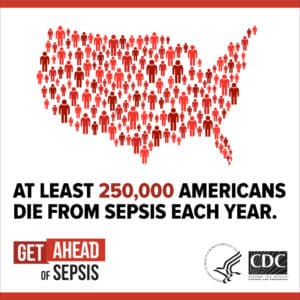Imagine species identification for some of the most common and deadly sepsis-causing pathogens— without having to wait 1 to 5 days or more for blood culture results.
Patient Health
Early targeted therapy improves patient outcomes; every hour delay of effective antibiotic therapy increases mortality by almost 8% in patients with septic shock. A positive ESKAPE or Candida test result may enable rapid targeted treatment and prevent a serious bloodstream infection from progressing to sepsis. Faster identification of sepsis-causing pathogens means patients are on targeted therapy faster— saving costs for unnecessary antibiotics— and enabling clinicians to treat the source of infection faster. In clinical studies, the T2Bacteria Panel (RUO) identified opportunities to escalate and de-escalate with confidence in patients who were ineffectively treated. (T2-704-4/18 for reference 1) Read more on how Lee Health made a positive impact on patient health.
Laboratory
Sepsis is defined as a life-threatening medical emergency by the CDC. New direct-from-whole blood T2Direct Diagnostics™ are the only FDA-cleared tests proven to complement traditional blood culture methods by identifying the most common and deadly organisms in 3 to 5 hours. Studies demonstrate both the T2Bacteria® Panel and T2Candida® Panel are able to detect some of the most common and clinically relevant pathogens at a limit of detection (LoD) as low as 1 CFU/mL and with a high degree of sensitivity and specificity. The easy to use T2Dx® Instrument is powered by T2MR technology and is not only easy to use but also fits within the most space-constrained environment. The fully automated, walkaway instrument is a clinical multiplex benchtop diagnostic system capable of running tests directly from 3-4 mL of whole blood.
Improved Stewardship Goals
Antibiotic resistance is a growing concern worldwide and a major public health threat. Overuse and inappropriate antibiotic use in patients are a root cause, as patients are being treated for infections empirically without knowing if they are actually infected, often exposing them to incorrect or unnecessary antibiotic therapy. This greatly decreases their chances of survival and increases the problem of antimicrobial resistance. Stewardship Committees are chartered with optimizing the utilization of antimicrobials for the best patient care while minimizing unintended consequences associated with antimicrobial exposure. The inclusion of faster ID of sepsis-causing pathogens as part of a hospital’s stewardship initiatives can enable faster time to improved patient outcomes and de-escalation of antimicrobial drug use. Patient outcomes include reduced hospital and ICU length of stay and de-escalation of unnecessary therapies. More effective use and better cost management of antimicrobial drugs, with the ability to make rapid adjustments, can reduce resistance while improving antimicrobial stewardship and potentially reduce morbidity and mortality outcomes resulting in reducing the cost of sepsis management. Read more about how labs are improving stewardship at Riverside Hospital.
1. Kumar, A, et al. Critical Care Medicine, 2006.